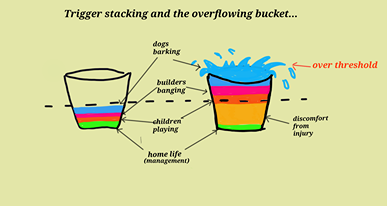Trigger stacking
Trigger stacking in equine training refers to the accumulation of stressors or triggers that can overwhelm a horse's ability to cope, leading to adverse reactions or behavioural issues. Each horse has its own threshold for stress, and when multiple stressors occur simultaneously or in quick succession, they can "stack up" and push the horse past its threshold, resulting in fear, anxiety, aggression, or other undesirable behaviours.

Some common stressors or triggers in equine training include:
- Loud noises: Such as fireworks, machinery, or sudden loud voices.
- Novel environments: New places, objects, or situations that the horse is unfamiliar with.
- Physical discomfort: Ill-fitting tack, injuries, or health issues.
- Unpredictable or inconsistent handling: Inconsistent cues or corrections from the rider or handler.
- Social stress: Being separated from other horses, encountering unfamiliar horses, or feeling threatened by dominant herd members.
When multiple stressors occur simultaneously or in rapid succession, the horse may become overwhelmed and react in ways that are unsafe for both itself and its handlers. It's essential for trainers and handlers to recognize potential triggers and manage them effectively to avoid trigger stacking and maintain the horse's emotional well-being.
Strategies for managing trigger stacking in equine training include:
- Desensitization and counter-conditioning: Gradually exposing the horse to various stressors in a controlled manner while providing positive reinforcement to help the horse associate the triggers with positive experiences.
- Consistent and clear communication: Providing clear and consistent cues to the horse to reduce confusion and anxiety.
- Adequate rest and recovery: Ensuring the horse has sufficient downtime between training sessions to rest and recuperate, reducing the likelihood of stress accumulation.
- Environmental management: Minimizing potential stressors in the horse's environment and ensuring a safe and predictable training environment.
- Recognizing signs of stress: Being aware of the horse's body language and behaviour cues that indicate stress or discomfort, and adjusting training techniques accordingly.
By understanding trigger stacking and implementing appropriate management strategies, trainers can help horses develop confidence, trust, and resilience, leading to safer and more successful training experiences.
.png)



